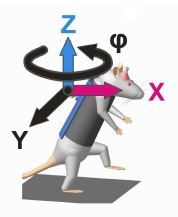
Do you ever look at the world around you and think, "How did we get here?" How did we come to live in a world with so much amazing technology? I frequently marvel at the amount of time and engineering that goes into the devices and processes we use every day. And then sometimes, we get a glimpse into the development of what is sure to be the technology of the future. The readers of this week's issue of Science received just such a preview, in the paper humbly titled, "Restoring Voluntary Control of Locomotion after Paralyzing Spinal Cord Injury" (you can read the paper here; subscription required).
[caption id="attachment\\_4649" align="alignright" width="178" caption="A cartoon of the rat harness used to assist and measure rehabilitation. Image credit: van den Brand, et al."][](http://www.sciencemag.org/content/336/6085/1182)[/caption]
The team of Swiss researchers made two cuts in the spinal cords of adult female rats—not enough to completely sever the cord, but enough to cut off major pathways for signaling between the brain and the hind legs. Then they treated the rats using drug injections and electrical stimulation of the injured segments. To test whether or not the rats regained any motor function, they strapped them into harnesses that allow a full range of motion and enticed to move with food. Normally, a hungry rat's brain would send signals telling her legs to move, but since the nerves carrying those signals were cut, she shouldn't have been able to move at all.
Amazingly, the rats that received the electrochemical treatment actually began walking, and eventually even running up stairs! A movie showing the rats and explaining the procedure is here. The scientists found that the neurons near the injury had formed new connections, bypassing the "broken circuits" to find other ways of sending information from the brain to the muscles.
The New York Times covered this story, describing the recovering rats this way: "They lurched forward like furry paratroopers, unsteady on their feet after a hard landing." It sounds like something out of an undiscovered sequel to the Rats of NIMH series, but this is a true story. This is science in action.
Of course, I'm required to temper your enthusiasm by reminding you that these rats didn't have their spinal cords cut completely. And in general, we should remember that what works in rats doesn't necessarily work in humans. Nonetheless, this is exciting evidence that someday, people who might have suffered life-long paralysis could learn to walk again, and they will have researchers like these (and their brave rodent subjects) to thank for it.
![]() van den Brand, R., Heutschi, J., Barraud, Q., DiGiovanna, J., Bartholdi, K., Huerlimann, M., Friedli, L., Vollenweider, I., Moraud, E., Duis, S., Dominici, N., Micera, S., Musienko, P., & Courtine, G. (2012). Restoring Voluntary Control of Locomotion after Paralyzing Spinal Cord Injury Science, 336 (6085), 1182-1185 DOI: 10.1126/science.1217416
van den Brand, R., Heutschi, J., Barraud, Q., DiGiovanna, J., Bartholdi, K., Huerlimann, M., Friedli, L., Vollenweider, I., Moraud, E., Duis, S., Dominici, N., Micera, S., Musienko, P., & Courtine, G. (2012). Restoring Voluntary Control of Locomotion after Paralyzing Spinal Cord Injury Science, 336 (6085), 1182-1185 DOI: 10.1126/science.1217416



